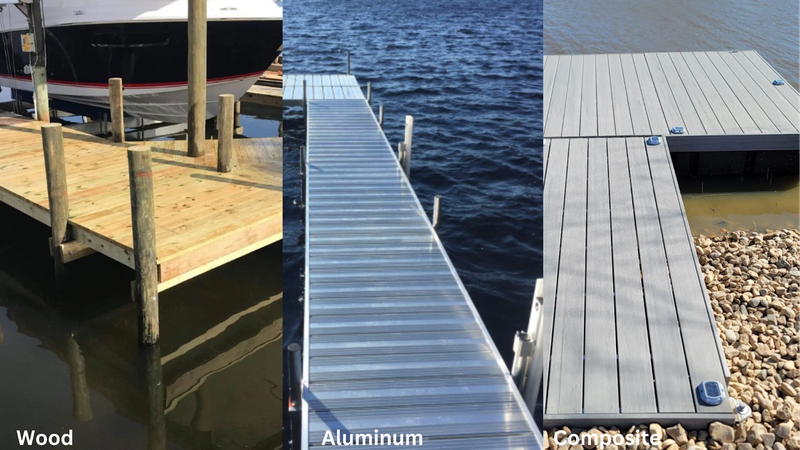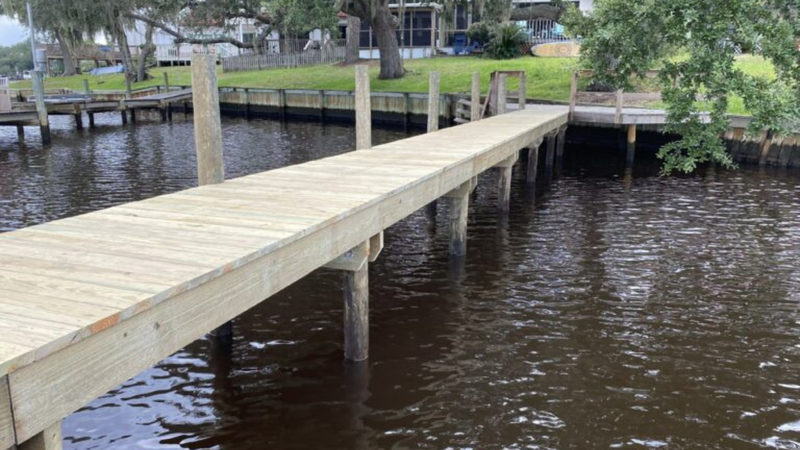
The choice of dock materials is a crucial decision when building a dock. It isn’t just about adding a structure to your shoreline—it’s about enhancing your lifestyle, increasing your property’s functionality, and creating a personal connection to the water. A well-planned dock opens the door to countless recreational activities, from kayaking and paddleboarding to quiet mornings with coffee by the water. But getting it right starts with one crucial decision: the dock materials you choose.
Whether you’re working on a residential dock in a peaceful cove or designing a full-service marina along the vibrant Florida Panhandle coast, your choice of dock materials will determine not only the lifespan and aesthetics of your dock but also how much time and money you’ll spend on upkeep in the years to come.
Different dock materials respond uniquely to environmental elements like UV rays, humidity, and saltwater exposure. With options ranging from time-tested pressure-treated lumber to sleek aluminum and modern composite alternatives, it’s important to know the pros, cons, and costs tied to each one.
In this guide, we’ll take you through a detailed breakdown of the most popular dock materials, key environmental and budgetary considerations, real-world examples, and how expert builders like Summit Marine Development can make all the difference.

Popular Dock Construction Materials
Choosing the best dock construction material isn’t just about personal style—it’s about matching your needs to what the environment demands. A dock exposed to the briny air of the Gulf Coast requires a different strategy than one sitting on the edge of a freshwater lake. While all docks serve the same general function, the materials they’re made from will greatly affect their strength, appearance, and how often they need maintenance.
Let’s explore the leading materials used in dock construction and what makes each one unique.
1. Pressure-Treated Wood
Pros: Pressure-treated lumber has been a staple in dock construction for decades. It’s readily available and typically more affordable than other options, making it an attractive choice for homeowners on a budget. This type of wood is chemically treated to resist moisture and insect damage, helping extend its lifespan. Its warm, natural appearance adds a rustic charm that blends beautifully with natural landscapes.
Cons: Despite the treatment, wood remains vulnerable to the elements. In humid climates like Florida’s, untreated edges and wear over time can lead to rot, mildew, and pest infestations. It requires annual maintenance—sealing, staining, and periodic repairs—to keep it looking and performing its best. Over time, even pressure-treated wood can warp, splinter, or discolor if not properly maintained.
🌊 Best For: Freshwater environments and docks where aesthetics and budget are priorities, and the owner is comfortable performing regular maintenance.
2. Marine-Grade Aluminum
Pros: Marine-grade aluminum is a powerhouse material for coastal dock construction. Its natural resistance to rust and corrosion makes it ideal for saltwater applications, especially along the Gulf Coast where docks must face daily exposure to salt spray and humidity. It’s also lightweight, which simplifies the installation process, and it retains its structural integrity for decades with minimal upkeep.
Cons: Aluminum’s industrial look can be a turn-off for some homeowners seeking a more organic or traditional dock appearance. While it can be painted or paired with decorative touches like composite decking or wooden accents, it often costs more upfront than wood. However, this higher initial investment usually pays off over time due to its low maintenance requirements and exceptional longevity.
🌊 Best For: Saltwater dock construction in high-moisture, high-wear environments like bays, inlets, and oceanside homes.
3. Composite Materials
Pros: Composite decking has grown in popularity due to its resilience and sleek appearance. Made from a blend of recycled plastics and wood fibers, composite dock boards resist mold, mildew, insect damage, and UV exposure. These dock materials don’t crack or warp like wood and never require sealing or staining. Many brands offer realistic wood-look textures and a wide range of colors, allowing for fully customized designs.
Cons: The biggest drawback is the price. Composite dock materials can be significantly more expensive than pressure-treated wood, although their durability and low maintenance costs often justify the upfront expense. Occasional washing is typically all that’s needed to keep composite docks looking fresh.
🌊 Best For: Homeowners seeking sustainable dock solutions with a sleek, modern style and minimal maintenance requirements.
Factors to Consider When Choosing Dock Materials
While the choice of dock materials is a major decision, it should always be informed by a variety of environmental and functional factors. Building a dock without considering the specific conditions it will face can lead to premature failure, safety concerns, and high replacement costs.
Here are the most important elements to evaluate when planning your dock build.
1. Water Conditions
Saltwater and freshwater environments differ dramatically in their impact on building materials.
- Freshwater poses fewer corrosion risks, making pressure-treated wood a viable and cost-effective option for lakeside properties. However, you’ll still need to protect the dock from moisture and biological threats.
- Saltwater, however, is highly corrosive and demands heavy-duty dock materials like aluminum, stainless steel, or premium composites that won’t degrade quickly in a marine setting.
For coastal properties along the Florida Panhandle, salt-tolerant dock materials are non-negotiable.
2. Climate and Weather
Florida’s coastal climate brings intense sun, seasonal storms, high humidity, and even hurricanes. Dock materials must be able to handle sudden weather shifts, prolonged sun exposure, and constant moisture.
- Composite decking is UV-resistant and retains color without fading or cracking.
- Aluminum stands up well to wind, salt spray, and heavy use.
- Wood needs consistent maintenance to survive extreme weather and is more prone to warping or structural weakness if neglected.
3. Budget
Every project has a bottom line, and choosing dock materials often comes down to weighing initial costs against long-term expenses.
- Wood: Affordable to install but requires yearly maintenance, which adds up.
- Composite and aluminum: More expensive at first but require little to no maintenance, translating to cost savings over time.
Consider how long you plan to stay in your home and how much maintenance you’re willing to commit to when evaluating total cost of ownership.
4. Environmental Impact
For eco-minded homeowners, choosing dock materials that minimize environmental harm is a top priority.
- Composite materials often include recycled plastics and wood fibers, helping reduce the need for virgin timber and lowering your carbon footprint.
- These materials are durable and long-lasting, meaning less frequent replacement and fewer resources used over time.
Building with sustainability in mind ensures your dock enhances your lifestyle without taking a toll on the environment.
5. Aesthetics
A dock isn’t just a functional feature—it’s an extension of your home. The right dock materials can complement your property’s architectural style and landscape.
- Combine the warmth of wood with the strength of aluminum framing.
- Use composite decking for clean lines and contemporary finishes.
Whether your home is rustic or modern, there’s a material combination that will match both your functional needs and your style.

Dock Construction and Maintenance
Having the best dock materials is only half the battle. The other half is expert installation and consistent upkeep. A dock must be structurally sound, meet local building codes, and be safe for all types of use—from mooring boats to hosting family gatherings.
Professional Installation
A professional dock builder doesn’t just assemble planks—they engineer your dock to handle tides, weather, and years of use. At Summit Marine Development, we offer:
- Custom dock designs tailored to your shoreline and lifestyle
- Reinforced headers that boost durability during heavy use
- Thru-bolted cleats that secure your boat safely
- Materials chosen specifically for Florida’s harsh coastal conditions
Our team understands the nuances of waterfront builds and ensures every dock is as strong as it is stunning.
Regular Maintenance Tips
No matter the material, regular dock inspections and maintenance can help you avoid expensive repairs and safety issues. Here’s what to keep on your seasonal checklist:
- Twice-yearly inspections: Look for damage after major weather events.
- Surface cleaning: Remove algae, salt buildup, or organic debris.
- Wood sealing: Apply a water-repellent sealant annually if using timber.
- Quick repairs: Don’t let minor issues grow into major headaches.
Typical Costs and Dock Construction Timelines
Building a dock is a significant financial investment, but the price varies widely depending on size, materials, and complexity.
Cost Range
- Basic wood dock: $15,000–$30,000
- Composite or aluminum dock: $50,000–$100,000+
- Add-ons like lighting, boat lifts, or entertainment areas can raise the cost significantly.
Construction Timeline
- Permits and approvals: 2–6 weeks depending on local requirements
- Build time: 2–8 weeks based on design and site conditions
Plan your dock construction during off-peak weather months and work with an experienced contractor to avoid unnecessary delays.
Case Studies and Examples
A Saltwater Success in Panama City Beach
One homeowner needed a dock tough enough to handle constant salt exposure. Summit Marine Development delivered a sleek aluminum structure with zero rusting and minimal maintenance, tailored specifically to Gulf Coast conditions.
A Composite Wonder in Destin
Looking for style and sustainability, a coastal property owner chose composite dock materials. The result? A visually striking, eco-friendly dock that enhances both the home’s value and the environment.
Happy Customers Speak
“Summit helped me pick the perfect materials for my needs and ensured the dock perfectly matched my property. It’s both practical and beautiful!”
— Erica, Lynn Haven
Avoid These Common Dock Construction Mistakes
- Using untreated wood: It might save money now but will decay fast.
- Ignoring water type: The wrong dock materials in saltwater will corrode quickly.
- DIY builds: Without proper engineering, docks can be unstable.
- Focusing only on price: Cheap dock materials often cost more in repairs.
- Neglecting maintenance: A small problem today becomes a big one tomorrow.

Build With Confidence—Choose Summit Marine Development
At the end of the day, the right dock materials—and the right team—make all the difference. Whether you’re building a small family dock or a large commercial marina, Summit Marine Development is your trusted partner in custom dock construction.
With local expertise, high-quality materials, and a commitment to craftsmanship, we’ll help you bring your dream dock to life—beautiful, durable, and built to endure Florida’s coastal conditions.
Contact us today for a free consultation, and let’s build something extraordinary together.

Frequently Asked Questions (FAQs)
1. What is the best material for building a dock in Florida?
For coastal Florida docks, marine-grade aluminum and composite decking are the top choices due to their resistance to saltwater corrosion, UV exposure, and humidity. Composite is great for eco-conscious homeowners, while aluminum is perfect for durability and minimal upkeep.
2. How much does it cost to build a dock in the Florida Panhandle?
Dock construction costs in the Florida Panhandle typically range from $15,000 to over $100,000 , depending on dock materials, size, and add-ons like boat lifts or lighting. Basic wooden docks are on the lower end, while custom aluminum or composite docks with features land at the higher end.
3. Do I need a permit to build a dock in Florida?
Yes, you’ll need to obtain a dock permit before construction begins. The permitting process varies by municipality and can take several weeks, especially in areas with strict environmental regulations or shoreline protections. Summit Marine Development can guide you through it.
4. Can I build my own dock, or should I hire a professional?
While DIY dock kits exist, professional installation is strongly recommended —especially in coastal areas. Pros ensure your dock is structurally sound, built to code, and designed to handle tides, storms, and saltwater exposure.
5. How long does it take to build a dock?
From permits to completion, dock projects can take anywhere from 4 to 12 weeks . Factors like design complexity, material availability, site access, and weather conditions all influence the timeline. Working with an experienced contractor helps avoid delays.
6. How often should I maintain my dock?
Maintenance depends on the material. Wood docks should be inspected and resealed yearly, while composite and aluminum docks require occasional cleaning and post-storm checks. Regular maintenance extends the life and safety of your dock.
7. What dock material requires the least maintenance?
Aluminum and composite decking are the lowest-maintenance options. They don’t rot, warp, or need sealing like wood. A quick rinse a few times a year usually keeps them in top shape.
8. Can I mix materials for a dock build?
Absolutely. Many homeowners combine dock materials—for example, aluminum framing with composite decking —to balance durability, aesthetics, and budget. This hybrid approach is popular for both modern and traditional waterfront homes.
Want expert support choosing the right dock materials?
Summit Marine Development is here to help—from design and permitting to custom dock construction tailored to Florida’s waterfront needs. Book a free consultation today and let’s bring your waterfront vision to life.
